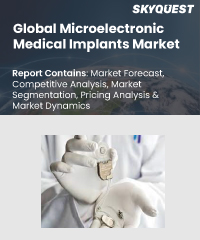
Report ID: SQMIG35A2689

Report ID:
SQMIG35A2689 |
Region:
Global |
Published Date: February, 2024
Pages:
157
|
Tables:
64 |
Figures:
75
The global microelectronic medical implants market is characterised by a competitive landscape driven by technological advancements, research and development, and strategic collaborations. Numerous companies and manufacturers are actively engaged in the development, production, and distribution of microelectronic medical implants, contributing to the growth and innovation in this sector. Key players in the microelectronic medical implants market are continuously investing in research and development to introduce cutting-edge products with enhanced functionalities and improved patient outcomes. These companies strive to stay ahead in the market by focusing on miniaturisation, improved biocompatibility, and wireless connectivity of their implants. Additionally, strategic partnerships with healthcare providers, research institutions, and other stakeholders play a crucial role in driving product innovation and expanding market presence. The market also witnesses the entry of new players, particularly startups and niche companies, that aim to capitalise on emerging opportunities and introduce specialised microelectronic medical implants for specific medical conditions. These innovative entrants often focus on addressing unmet medical needs and offering unique features to differentiate themselves from established competitors. Furthermore, the global microelectronic medical implants market is influenced by regulatory dynamics and compliance requirements set forth by governing bodies such as the U.S. Food and Drug Administration (FDA) and the European Medicines Agency (EMA). Companies must navigate complex regulatory pathways to obtain necessary approvals, which can impact their time-to-market and competitive advantage.
Microelectronic Medical Implants Market Top Player’s Company Profile
Microelectronic Medical Implants Market
Our industry expert will work with you to provide you with customized data in a short amount of time.
REQUEST FREE CUSTOMIZATIONWant to customize this report? This report can be personalized according to your needs. Our analysts and industry experts will work directly with you to understand your requirements and provide you with customized data in a short amount of time. We offer $1000 worth of FREE customization at the time of purchase.

Report ID: SQMIG35A2689